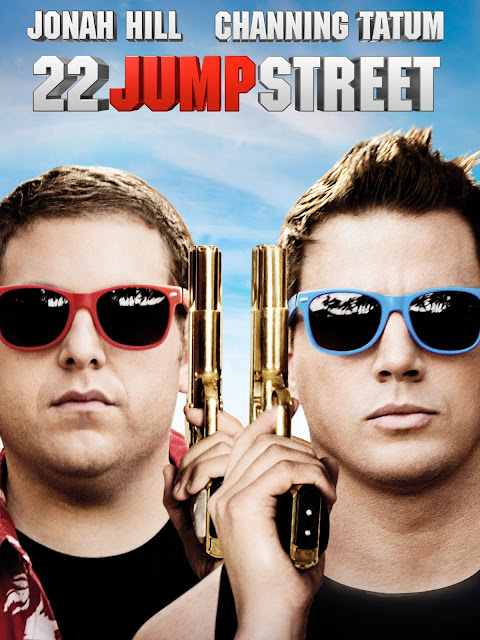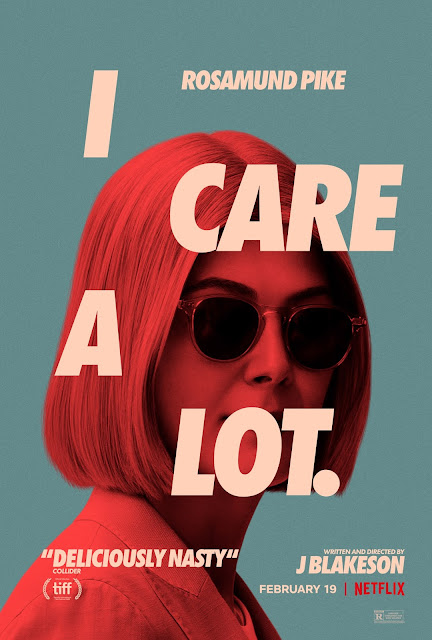Good morning,
In the scramble to finish yesterday's post before the end of the month, I was reminded of my ever-elusive, ever-aspirational goal of allowing myself to write shorter posts in the interest of maximizing how much I actually write. While I'm really glad I was able to carve out time for a longer-form post about a movie I really enjoyed, I still maintain it's overall better to allow myself to be brief so my overall engagement in writing is more consistent rather than in such fits and starts, and often at the end of the month, which is a reflection of how relegated to the end of the to do list writing for fun tends to be.
And also, not every movie deserves a long reflection.
Enter: "I Care A Lot" (2020).
Question: Did anyone need this movie?
Additional question: HOW did anyone LIKE this movie??
Yet another question: Does it sound to anyone like being in the midst of a pandemic that has disproportionately impacted and devastated facilities caring for the elderly, and when workers at those facilities are now routinely exposed to risks to their personal safety and well-being, overworked, and traumatized, is the right time to release a movie demonizing those workers???
Asking on behalf of this terrible, terrible movie.
As I attempt to answer these and other questions, buckle up for a post doused in competing showers of fuming exasperation and sarcasm because this is the only way I know how to cope with the crapsaster* that is this movie.
By way of brief synopsis for those blissfully unaware of this film: "I Care A Lot" stars Rosamund Pike in yet another cold psychopathic lady role, Marla Grayson, who postures as a legal guardian for vulnerable elderly people. In actuality, Marla works her web of corrupt doctors (worse yet: corrupt LADY doctors!) and elderly care homes, as well as the apparently sole judge in her jurisdiction who oversees cases related to legal guardianship who is apparently not on the take but is instead just incredibly suggestible (a cute choice for the only Black major character in the film), to enrich herself by stripping her wards of all of their assets and selling them for her own gain.
 |
| I, too, regularly pose smugly with my tiny espresso mug in front of my wall of victims. |
Beef Number One: This movie is so goddamned sexist. This movie exploits the indignant anger it expects of its audience at the proposition that a woman (you know, the people who are supposed to thanklessly mommy the whole world?) could be, *gasp!*, mean and bad!! The scant backstory Marla is granted alludes to her also mean and bad mother, because of course Marla's wickedness must also have its origins in the faults of women and their failures to caretake.
Much to the chagrin of my relevant pet peeves, Marla's meanness and badness announces itself through her appearance: She is an attractive, put-together, poised, and well-dressed lady in a role where I guess we're supposed to expect her to look more like a frazzled pseudo-social worker who shops at Goodwill. Instead, Marla is so conspicuously posh--to the point that it is ridiculous that anyone wouldn't spot her as a scam artist from a mile away.
 |
| WARNING: LADY WEARING WHITE STUFF |
Cue another movie in which apparently you should beware women who have recent razor's edge-straight, presumably expensive haircuts and wear too much white. We know how I feel about those movies.
Bonus Sub-Beef: Oh, Marla's gay? So we're demonizing not just women in general, but also specifically lesbians now? Cool. Yeah sure, that seems like a good take.
Beef Number Two: HOW DARE YOU MISALLOCATE THE TALENTS PETER DINKLAGE TO THIS SCHLOCK.
Beef Number Three: The initial premise of this movie is truly bad enough. The film is made no better by its sheer implausibility as it enters its third act, in which we are seriously meant to believe (oh no, surely we wouldn't spoil this gem in the grand history of cinema?) Dinklage's randomly Russian yet accentless mob boss, Roman Lunyov, sincerely agrees to partner up with Marla after she Rasputins her way out of a certain death of his engineering and manages to kidnap, drug, and entrap him via the very scheme she's been perpetrating all along? Oh yeah, that is totally something that guy would do.
 |
| Yes this a totally believable moment in which a friendship is formed and I accept it unquestioningly. |
Beef Number Four: Beyond the bizarre timing of the release of this film (I dunno, maybe it would have been wise to sit on this one a few years if you must release it at all?), it is also, irritatingly, a film that is extremely confused about what it actually is.
The film reaches its finale as Marla, at the epic height of her utterly implausible rocket to fame and fortune, is gunned down by the family member of an elder she exploited in her early days of being an evil gay lady wearing too-nice clothes. She is cradled by her sobbing girlfriend Fran (played by Eiza González) as she dies... tragically? Is this movie seriously trying to tell us that we're sad about this? You know you showed us she was really bad, right? What is happening??
 |
| Wut. |
In conclusion: I finished this movie out of sheer spite and I hated every minute of it. Surprising absolutely not one person, I gave this movie a 1.
Epilogue: Damn it, I wrote way too much about this dumpster of a film.
Until next time!
{Heart}
* = My new word for "crappy disaster", thanks to this mess of a movie.





































